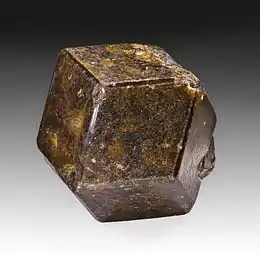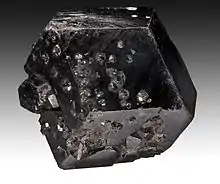Andradite
Andradite is a species of the garnet group. It is a nesosilicate, with formula Ca3Fe2Si3O12.
| Andradite | |
|---|---|
 Single crystal (4.2cm) – Diakon, Nioro du Sahel Circle, Kayes Region, Mali | |
| General | |
| Category | Garnet group |
| Formula (repeating unit) | Ca3Fe2(SiO4)3 |
| Strunz classification | 9.AD.25 |
| Crystal system | Cubic |
| Crystal class | Hexoctahedral (m3m) H-M symbol: (4/m 3 2/m) |
| Space group | Ia3d |
| Unit cell | a = 12.056 Å; Z = 8 |
| Identification | |
| Color | Yellow, greenish yellow to emerald-green, dark green; brown, brownish red, brownish yellow; grayish black, black; may be sectored |
| Crystal habit | Commonly well-crystallized dodecahedra, trapezohedra, or combinations, also granular to massive |
| Cleavage | none |
| Fracture | conchoidal to uneven |
| Tenacity | Brittle |
| Mohs scale hardness | 6.5 to 7 |
| Luster | Adamantine to resinous, dull |
| Streak | White |
| Diaphaneity | Transparent to translucent |
| Specific gravity | 3.859 calculated; 3.8–3.9 measured |
| Optical properties | Isotropic, typically weakly anisotropic |
| Refractive index | n = 1.887 |
| Absorption spectra | demantoid – 440nm band or complete absorption at 440nm and below, may also have lines at 618, 634, 685, 690nm [1] |
| References | [1][2][3][4] |
| Major varieties | |
| Demantoid | transparent light to dark green to yellow-green |
| Melanite | opaque black |
| Topazolite | transparent to translucent yellow, may show chatoyancy |
Andradite includes three varieties:
- Melanite: Black in color, referred to as "titanian andradite".[5]
- Demantoid: Vivid green in color, one of the most valuable and rare stones in the gemological world.[6]
- Topazolite: Yellow-green in color and sometimes of high enough quality to be cut into a faceted gemstone, it is rarer than demantoid.[6]
It was first described in 1868 for an occurrence in Drammen, Buskerud, Norway.[2][3][6] Andradite was named after the Brazilian statesman, naturalist, professor and poet José Bonifácio de Andrada e Silva (1763–1838).[2][6]
Occurrence
It occurs in skarns developed in contact metamorphosed impure limestones or calcic igneous rocks; in chlorite schists and serpentinites and in alkalic igneous rocks (typically titaniferous). Associated minerals include vesuvianite, chlorite, epidote, spinel, calcite, dolomite and magnetite.[2] It is found in Italy, the Ural Mountains of Russia, Arizona and California and in Dnipropetrovsk Oblast in Ukraine.
Like the other garnets, andradite crystallizes in the cubic space group Ia3d, with unit-cell parameter of 12.051 Å at 100 K.[7]
The spin structure of andradite contains two mutually canted equivalent antiferromagnetic sublattices[8] below the Néel temperature (TN=11 K[9]).
 Black crystals of andradite: melanite
Black crystals of andradite: melanite
See also
References
- Gemological Institute of America, GIA Gem Reference Guide 1995, ISBN 0-87311-019-6
- Handbook of Mineralogy
- Andradite, Mindat.org
- Webmineral data
- Melanite, Mindat.org
- Grande, Lance; Augustyn, Allison (2009). Gems and Gemstones: Timeless Natural Beauty of the Mineral World. University of Chicago Press. pp. 188–91. ISBN 978-0-226-30511-0.
- Thomas Armbruster and Charles A. Geiger (1993): "Andradite crystal chemistry, dynamic X-site disorder and structural strain in silicate garnets." European Journal of Mineralogy v. 5, no. 1, p. 59-71.
- Danylo Zherebetskyy (2010). Quantum mechanical first principles calculations of the electronic and magnetic structure of Fe-bearing rock-forming silicates, PhD Thesis, Universal Publishers/Dissertation.com, Boca Raton, Florida, USA, p. 136. ISBN 1-59942-316-2.
- Enver Murad (1984): "Magnetic ordering in andradite." American Mineralogist 69, no. 7-8; pp. 722–24.
External links
![]() Media related to Andradite at Wikimedia Commons
Media related to Andradite at Wikimedia Commons
